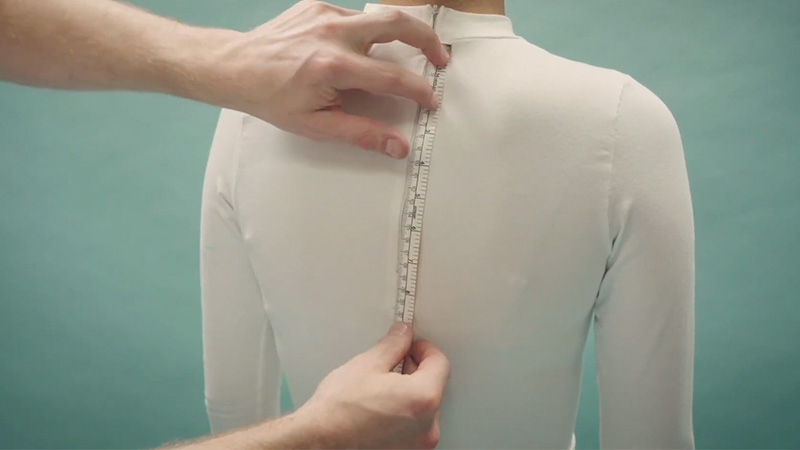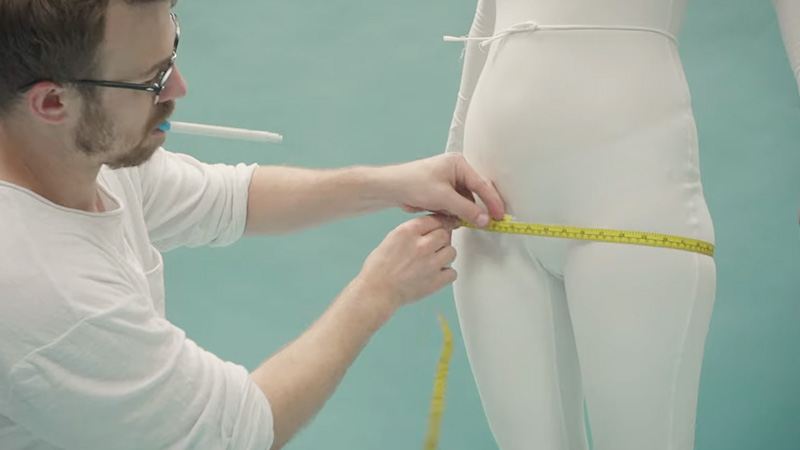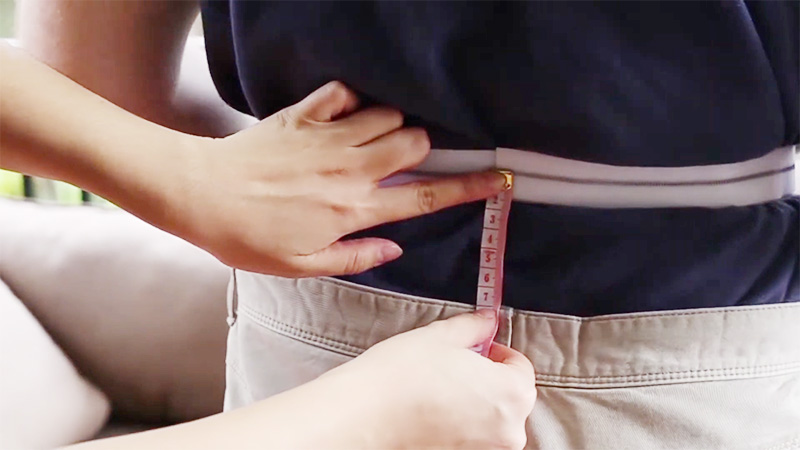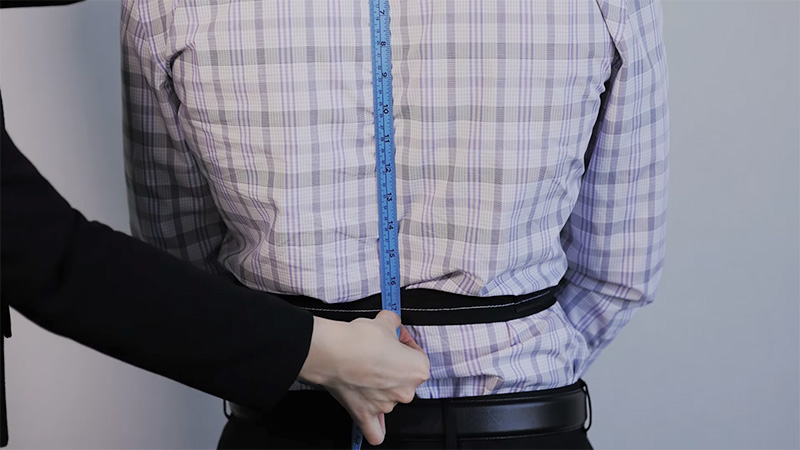Measuring back waist length is a pivotal process in the realm of garment creation, ensuring that clothing fits impeccably and flatters the wearer’s figure.
This crucial measurement determines the vertical distance from the base of the neck to the natural waistline, accommodating individual variations in posture and body shape.
Accurate back waist length measurements are the foundation of well-fitted dresses, blouses, jackets, and other tailored garments. In this guide, we’ll explore the step-by-step process, highlighting key considerations and techniques to guarantee precision.
Mastering this skill empowers designers, tailors, and fashion enthusiasts alike, enabling them to create clothing that not only fits beautifully but also exudes confidence and style.

What Is Back Waist Length?
Back waist length, often referred to as “BWL,” is a critical measurement in the world of fashion and garment design.
It represents the vertical distance from the base of the neck, where the neck meets the upper back, down to the natural waistline of an individual. This measurement is pivotal in tailoring well-fitted clothing such as dresses, blouses, jackets, and coats.
The accuracy of the back waist length measurement ensures that garments not only hang correctly but also provide comfort and enhance the wearer’s silhouette.
It is vital for customizing clothing to different body shapes and accommodating various styles, making it an essential component of the fashion industry’s pursuit of both style and functionality.
How Do You Measure Back Waist Length? – A Comprehensive Guide
Measuring back waist length is an essential step in creating well-fitting clothing, particularly for garments like dresses, blouses, and jackets.
It’s a crucial measurement because it determines the distance from the base of the neck to the natural waistline, which helps ensure that a garment fits comfortably and looks flattering on the wearer.
Here are the steps to measure back waist length accurately:
Gather Supplies
- A flexible measuring tape
- A mirror
Prepare the Subject
Ensure the person being measured is wearing a well-fitting, lightweight top made of a thin fabric. This choice minimizes any potential distortion caused by bulky clothing.
Ask them to stand naturally, with a straight back, shoulders relaxed, and arms comfortably at their sides. This posture ensures an accurate measurement, as any slouching or unnatural positioning may lead to inaccuracies.
Locate the Base of the Neck
To find the base of the neck, ask the person to tilt their head slightly forward. This motion exposes the area where the neck meets the upper back, often marked by a discernible bony prominence. Gently palpate the area if needed to confirm the precise location.
Locate the Waistline
The natural waistline is typically the narrowest part of the torso, situated approximately one inch above the belly button. To verify this, ask the person to perform a gentle side-to-side bend. The resulting crease serves as a reliable indicator of the natural waistline.
It’s crucial to emphasize that they should maintain a relaxed posture during this process, as any tension can lead to an incorrect measurement.
Position the Measuring Tape
Holding the measuring tape against the back, align it precisely with the base of the neck. Ensure it rests perfectly parallel to the floor, following the natural curvature of the spine.
Take care not to pull the tape too tightly; it should rest comfortably against the body without causing any compression or distortion.
Measure Down to the Waistline
While maintaining the tape’s tautness, slowly descend from the base of the neck to the natural waistline.
Proceed with meticulous care, ensuring the tape remains in a straight line without any dips or rises. This meticulous approach guarantees an accurate representation of the back waist length.
Record the Measurement
Once you’ve reached the natural waistline, take note of the measurement. Record it meticulously in both inches and centimeters for convenient reference. If possible, read the measurement from the side to avoid any potential parallax error.
Double-Check for Accuracy
To ensure precision, repeat the measurement process. This additional step serves as a valuable confirmation of the initial measurement’s accuracy.
If available, make use of a mirror to scrutinize the tape’s alignment and evaluate the overall posture of the person being measured.
Consider Any Adjustments
Depending on the specific type of garment you’re creating, you may find it necessary to make subtle adjustments to the back waist length. For instance, a garment with a dropped waist or a high-waisted design might require modifications to guarantee a flawless fit that complements the wearer’s figure.
Importance of Measuring Back Waist Length

Measuring back waist length holds paramount importance in garment creation and tailoring.
Here’s why it’s a critical step:
Custom Fit
Back waist length measurement ensures that a garment fits a specific individual perfectly. It accounts for variations in body shape, posture, and proportions, resulting in a comfortable and flattering fit.
Enhances Comfort
A garment with the correct back waist length allows for ease of movement and prevents discomfort caused by tightness or excess fabric. This is particularly vital for clothing worn for extended periods.
Proportional Balance
Properly measured back waist length contributes to the overall balance and proportion of a garment. It ensures that the waistline and any design elements (like belts or waistbands) sit at the right position on the wearer’s body.
Aesthetic Appeal
A well-fitted garment with the right back waist length enhances the wearer’s silhouette, highlighting their natural curves and features. It contributes to a polished and put-together look.
Supports Design Integrity
For designers, accurate back waist length measurements are essential for bringing their design vision to life. It ensures that the garment’s intended silhouette and style details are realized effectively.
Reduces Alterations and Returns
Precise measurements at the back waist help minimize the need for post-production alterations or returns due to ill-fitting garments. This saves both time and resources.
Professionalism in Tailoring
For tailors and seamstresses, the ability to take accurate back waist length measurements demonstrates professionalism and skill. It instills confidence in clients regarding the quality of their work.
Versatility in Design
Knowing the accurate back waist length enables designers to create a wider range of styles and silhouettes. This includes high-waisted or low-waisted designs, allowing for greater creative expression.
Comfort for Special Occasions
For special occasions like weddings or formal events, precise measurements are essential. They ensure that the wearer looks and feels their best, especially in garments that are worn for extended periods.
Common Mistakes and How to Avoid Them

When measuring back waist length, there are a few common mistakes that can lead to inaccurate measurements.
Here are these mistakes and how to avoid them:
Using a Stretchy or Inflexible Tape Measure
- Mistake: Using a tape measure that stretches or doesn’t stay in shape can lead to inaccurate measurements.
- Solution: Always use a flexible, non-stretch tape measure made of fabric or plastic. Make sure it lies flat and straight against the body.
Incorrect Starting Point at the Base of the Neck
- Mistake: Starting the measurement too high or too low on the neck can result in an incorrect back waist length.
- Solution: Ensure the measuring tape is positioned precisely at the base of the neck, where it meets the upper back.
Failure to Locate the Natural Waistline
- Mistake: Misjudging the natural waistline, especially if the person being measured is not in a relaxed posture, can lead to an inaccurate measurement.
- Solution: Have the person gently bend from side to side to help locate the narrowest part of their torso, which is the natural waistline.
Pulling the Tape Too Tight or Allowing it to Sag
- Mistake: Pulling the tape too tightly or allowing it to sag can result in measurements that are too small or too large.
- Solution: Keep the tape taut but not tight against the body, ensuring it maintains a straight line from the base of the neck to the natural waistline.
Not Measuring Parallel to the Floor
- Mistake: Allowing the measuring tape to angle up or down instead of staying parallel to the floor can lead to inaccurate measurements.
- Solution: Pay close attention to the tape’s orientation and make sure it follows the natural curvature of the spine while remaining parallel to the floor.
Neglecting to Double-Check for Accuracy
- Mistake: Failing to measure twice for confirmation can result in relying on an inaccurate initial measurement.
- Solution: Always measure back waist length at least twice to ensure consistency and accuracy.
Ignoring Individual Body Variations
- Mistake: Assuming that one measurement fits all can lead to ill-fitting garments, especially when dealing with unique body shapes or postural differences.
- Solution: Customize measurements to suit each individual’s unique body shape, taking into account any specific adjustments needed for an optimal fit.
Not Considering Garment Design or Style
- Mistake: Forgetting to factor in design elements like dropped or high waists can lead to garments that don’t fit properly.
- Solution: Adjust the back waist length measurement based on the specific design and style of the garment being created.
Tips for Accuracy

Achieving accuracy when measuring back waist length is crucial for crafting well-fitting garments.
Here are some tips to ensure precise measurements:
Use a Reliable Measuring Tape
A high-quality, non-stretch measuring tape is essential. Over time, tapes can wear out or stretch, leading to inaccurate measurements. Inspect the tape regularly and replace it if it shows signs of wear.
Maintain a Consistent Posture
Emphasize the importance of good posture to the person being measured. A straight back and relaxed arms ensure that measurements are taken from a consistent starting point, minimizing potential errors.
Locate Landmarks Carefully
Take time to locate key points like the base of the neck and the natural waistline. Use gentle touch or visual cues to ensure precise placement of the measuring tape.
Keep the Tape Parallel to the Floor
When measuring horizontally or vertically, it’s crucial to keep the tape parallel to the ground. This prevents distortion that can occur if the tape is angled.
Avoid Pulling Too Tightly
Stress the importance of maintaining a snug, but not constricting, fit with the measuring tape. Pulling too hard can compress the skin and lead to inaccurate measurements.
Double-Check and Measure Twice
This practice adds an extra layer of assurance. Repeating measurements helps catch any inconsistencies or errors, ensuring that the final measurement is as accurate as possible.
Consider Garment Style
Understand the design elements of the garment being created. For instance, a fitted dress may require a slightly different measurement compared to a loose-fitting blouse. Take these factors into account for a customized fit.
Account for Individual Body Shape
Recognize that everyone’s body is unique. Some individuals may have more prominent shoulder blades, a curved back, or other distinct features. Make adjustments to the measurement technique to accommodate these variations.
Document Measurements Clearly
Accurate record-keeping is essential. Clearly document measurements in both inches and centimeters and use a system that’s organized and easy to reference. This ensures that the correct measurements are used during garment construction.
Practice Patience and Precision
Rushed measurements are more likely to lead to inaccuracies. Encourage a measured, deliberate approach. Taking the time to measure accurately will ultimately save time and frustration in the long run.
FAQs
What is Back Waist Length (BWL)?
It’s the measurement from the base of the neck to the natural waistline.
Why is BWL important for fitting?
Ensures well-proportioned and comfortable clothing.
How do I measure BWL?
Start at the base of the neck and measure down the spine to the waistline.
What if my measurement falls between sizes?
Choose the larger size and adjust if needed.
Can I measure BWL alone?
It’s best to have assistance for accuracy. Use a mirror if measuring alone.
To Recap
Measuring back waist length is a crucial aspect of creating well-fitted garments. This measurement, taken from the base of the neck to the natural waistline, serves as a foundation for tailoring.
It ensures that tops and dresses hang properly and skirts fit snugly at the waist. Accurate back waist length also affects the overall silhouette, enhancing comfort and style. Precision is key, as even small discrepancies can lead to ill-fitting attire.
Whether for personal sewing projects or professional garment production, understanding and measuring back waist length is fundamental in achieving a flattering and comfortable fit, ultimately elevating the quality and aesthetics of the finished piece.
Leave a Reply